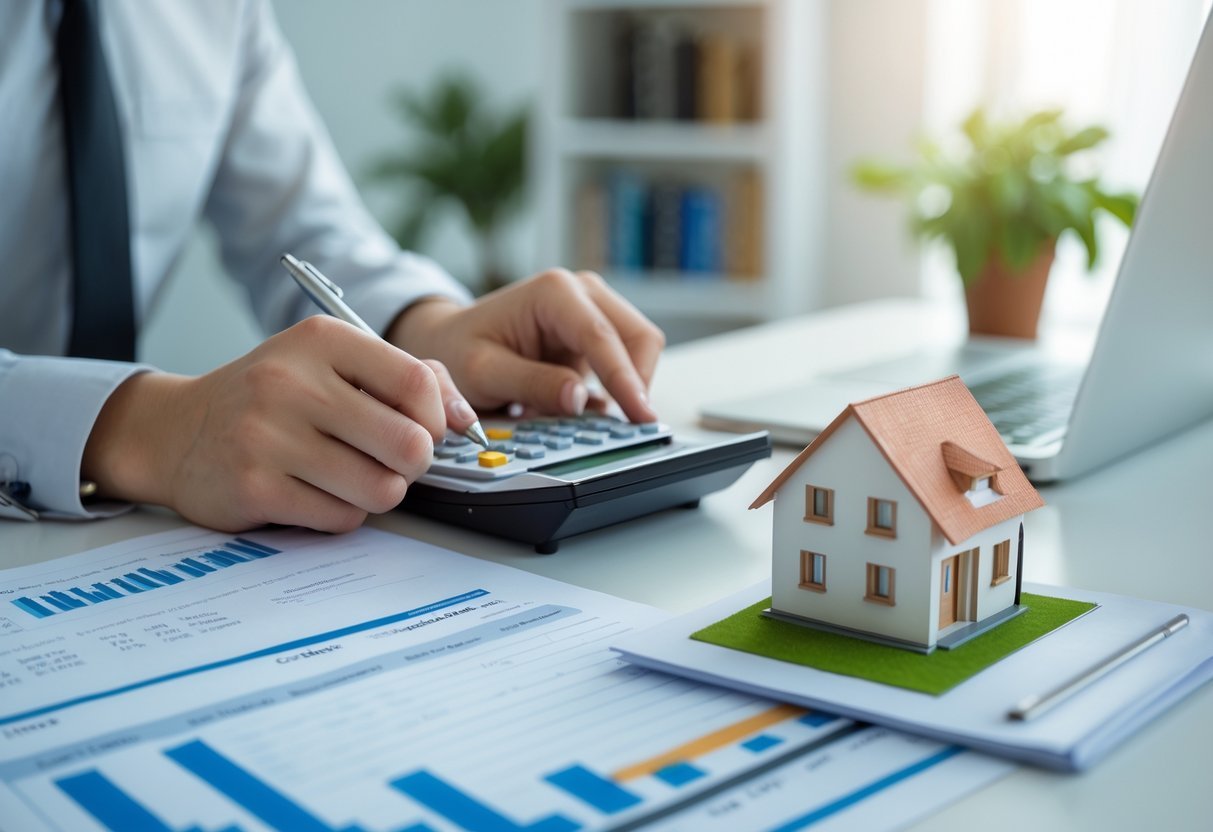When considering an investment in real estate, knowing how to assess the potential return is essential. Cap rate, or capitalization rate, is a straightforward calculation you can use to quickly compare rental properties and determine how much income a property could generate relative to its price. By mastering this calculation, you make smarter decisions about where to invest your time and money.
Cap rate calculation involves dividing a property’s net operating income by its market value, resulting in a percentage that reflects the expected annual return on your investment. It’s a widely used method among real estate investors to evaluate not just profitability, but also risk levels, across various types of rental property. Learning how to accurately calculate and interpret this rate can give you a strong advantage in a competitive real estate market.
Key Takeaways
- Cap rate helps you evaluate a rental property’s investment potential.
- Calculation requires net operating income and current market value.
- Understanding cap rate lets you compare different real estate opportunities.
Understanding Cap Rate Calculation for Rental Property
Cap rate, or capitalization rate, is a key financial metric used by many real estate investors to evaluate the profitability of a rental property. Calculating cap rate involves understanding specific financial details and applying a straightforward formula to estimate a property’s potential return.
What Is Cap Rate?
Cap rate stands for capitalization rate and serves as a quick gauge of a rental property’s investment potential. It measures the expected rate of return on a real estate investment property, based on the property’s net operating income and its current market value or purchase price.
This metric helps you compare different investment opportunities in real estate. A higher cap rate generally indicates higher risk and greater potential return, while a lower cap rate suggests lower risk but also lower return. You can use cap rate to assess both single-family and multifamily properties.
Key Components of Cap Rate
To accurately calculate cap rate, you need a clear understanding of two fundamental figures: Net Operating Income (NOI) and property value or purchase price.
- Net Operating Income (NOI): This is your total annual rental income minus your annual operating expenses, such as property management, taxes, insurance, repairs, and maintenance.
- Purchase Price or Market Value: This is the cost to acquire the property or its appraised market value if you already own it.
You must exclude mortgage payments and financing costs, as cap rate focuses strictly on the property’s income and costs, not your personal financing arrangements. Using a good cap rate calculator can help you accurately estimate ROI.
Cap Rate Formula and Example
The cap rate formula is:
Cap Rate = (Net Operating Income / Purchase Price) x 100
For example, if a rental property generates $24,000 in annual rental income, and annual operating expenses are $9,000, the NOI is $15,000. If you paid $250,000 for the property, cap rate calculation would be:
($15,000 / $250,000) x 100 = 6%
You can find further breakdowns and calculation steps in guides like How to Calculate Cap Rates for Rental Real Estate and Investopedia’s overview of capitalization rate. This approach helps you estimate and compare potential returns from various investment properties accurately.
Factors Influencing Cap Rate and Its Application
Getting an accurate cap rate calculation means understanding the financial details of the property and how different investment options compare. Key financial figures, risk factors, and market conditions all contribute to the cap rate and what it tells you about a rental property.
Income, Expenses, and Net Operating Income
The first step in determining cap rate is establishing net operating income (NOI). Calculate this by subtracting all operating expenses—such as property management fees, maintenance costs, insurance, property taxes, and utilities—from your gross rental income.
For instance, if your monthly rental income is $2,000 and yearly operating expenses total $6,000, your annual NOI would be $18,000. Don’t include mortgage payments, income taxes, or depreciation in this figure.
Use NOI for the cap rate formula and not gross income. This distinction is key for assessing a property’s profitability in a realistic way. Tools like the 50% rule can help estimate expenses quickly when reviewing properties.
Comparing Different Investment Properties
Cap rate helps you compare various types of investment properties, such as single-family homes, duplexes, and commercial buildings. For example, a single-family home in a stable neighborhood might show a lower cap rate but offer more predictable income, while a multi-unit duplex or commercial property may promise a higher cap rate but come with greater operating history complexity.
You can list multiple properties in a table:
| Property Type | NOI | Market Value | Cap Rate |
|---|---|---|---|
| Single-family home | $18,000 | $300,000 | 6.0% |
| Duplex | $36,000 | $500,000 | 7.2% |
| Commercial property | $75,000 | $1,000,000 | 7.5% |
These differences in cap rate highlight varying levels of cash flow, appreciation potential, and expenses. Comparing cap rates ensures you are weighing your cash invested and anticipated return in a consistent way across property types.
Evaluating Risk, Return, and Market Factors
Cap rate reflects both the potential return and the risk tied to a property. Properties in areas with rising demand or strong appreciation often produce a lower cap rate because the risk of vacancy or loss is perceived as lower. Conversely, a higher cap rate signals higher risk, such as uncertain rental markets, high maintenance costs, or less desirable locations.
Key market factors that influence cap rate include interest rates, tenant quality, vacancy rates, and anticipated rent growth. Also, when interest rates go up, cap rates may rise to compensate for higher mortgage costs, impacting the attractiveness of cash-on-cash return and internal rate of return (IRR).
In your real estate investing analysis, consider not just a “good cap rate” but also closing costs, selling prospects, and tax benefits, as these affect overall return on investment and cash flow. Learn more about additional factors influencing cap rate to strengthen your investment decisions.
Frequently Asked Questions
Understanding how to calculate and use cap rates can help you assess risk, forecast returns, and compare properties. Knowing what influences cap rate and how to use it builds the foundation for well-informed investment decisions.
How is the capitalization rate, or cap rate, determined for a rental property?
You determine the cap rate by dividing a property’s net operating income (NOI) by its current market value. This figure is usually expressed as a percentage. The formula is: Cap Rate = Net Operating Income / Market Value.
To see specific examples and more on the calculation, see this cap rate definition with formula.
Can you explain the 1% and 2% rules in relation to cap rates for rental investments?
The 1% and 2% rules offer quick ways to check a rental’s monthly income versus its purchase price. If a property rents for at least 1% (or 2%) of its purchase price each month, it may indicate a higher potential return.
These rules are only screening tools. For more accuracy, always calculate the actual cap rate.
What factors should be considered when evaluating a cap rate for a property investment?
When evaluating cap rate, consider the property’s location, age, condition, and local market trends. Vacancy rates, expenses, and the stability of rental income also influence the cap rate’s reliability.
A higher cap rate can sometimes signal greater risk, such as higher vacancy or lower property demand. A lower cap rate often indicates more stable or desirable markets.
What defines a ‘good’ cap rate when looking at potential rental property investments?
A “good” cap rate depends on your investment goals and risk tolerance. In many markets, residential rental properties have cap rates between 4% and 10%, but this range can vary widely.
Typically, higher cap rates mean greater potential returns but higher risks. Lower cap rates may indicate safer, more stable areas. More details can be found in this guide to good cap rates for rentals.
How does net operating income (NOI) influence the cap rate of a rental property?
Net operating income (NOI) is the key metric used to calculate cap rate. If NOI increases and the property value stays the same, the cap rate rises. If NOI decreases, the cap rate falls.
All income and expenses, except mortgage payments and taxes, should be included in your NOI calculation.
What methods are commonly used to calculate the value of a rental property based on cap rate?
To estimate a property’s value, divide the net operating income by the target cap rate. For example, if a property’s NOI is $30,000 and you want a 6% cap rate, the estimated value would be $500,000.
You can use tools like this cap rate calculator to run quick calculations for different scenarios.




